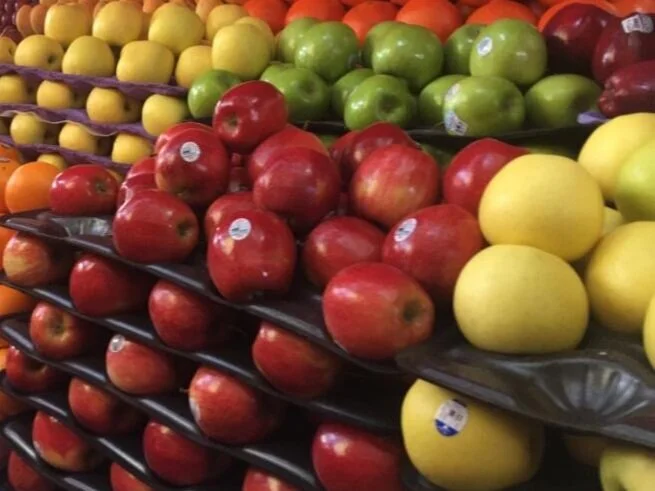Feeding
& all of your senses.
Many children with severe, complex and profound special educational needs may experience feeding challenges. This might be because of Dysphagia (physical difficulties that make it unsafe to swallow), because of physical, physiological or psychological challenges or because of sensory integration challenges which make it an unpleasant and difficult experience. For most children it is a complex combination of multiple factors that requires assessment from a multi-disciplinary team in order to understand.
Whenever offering food related play, please ensure that you discuss it with the child’s dysphagia trained Speech and Language Therapist to make sure that it is safe for a child to do so and take into account any dietary requirements.
Sensory Integration.
Feeding is one of the most complex things that we require our body to do because it involves the integration of information from every sensory system - and there are 8! Sensory Integration develops through experiences. If we are not effectively or efficiently receiving, perceiving and interpreting sensory information about our body and our environment, we may have difficulty learning and developing new skills and participating in every day activities such as feeding.
Below, we describe how children might respond at snack and mealtimes if they are experiencing challenges in each of the sensory systems. This is not an exhaustive list and if you are concerned about a child’s feeding then we recommend that you request an assessment with a feeding specialist trained in Ayres Sensory Integration.
Visual.
Only accept foods of a certain colour, shape or size.
Become distressed if different foods are touching on their plate.
Closes eyes when presented with food.
Does not recognise foods prepared in different ways.
Does not accept preferred foods if they are broken.
Auditory.
Dislikes eating crunchy food like carrots and apples (try it and listen to what it sounds like).
Becomes distressed or distracted in busy environments. For example restaurants, supermarkets or school dinner halls.
FACT:
The gustatory system is our sense of taste. Sensory receptor cells on our tongue tell us if a food is sweet, salty, sour, bitter or savoury. The olfactory system is our sense of smell which gives us information about the flavour of food and why we might say things like “it smells so good I can taste it”. Due to the physiology of the nasal and oral cavity, as we chew food, our experience of taste and flavour can change.
Gustatory (Taste).
Extreme responses to different tastes.
Under reacts to different tastes.
Licks or eats inedible items. For example paint, glue, playdough.
Diet restricted to plain, bland foods.
Gags or vomits in response to particular tastes.
Olfactory (Smell).
Pinches nose when presented with particular smells.
Describes every day scents as disgusting or yucky - for example the smell of perfume, freshly baked bread or fresh flowers.
Complains of headaches when overwhelmed with scents in restaurants or school dinner halls.
Gags or vomits in response to particular smells.
Proprioception (muscle stretch).
Frequently looses food on the way to their mouth. Poor hand to mouth coordination means food often misses mouth.
Delayed oral motor skills makes food consistencies challenging. For example dribbles often, cannot close lips when eating, bites tongue and cheeks frequently.
Difficulty placing mealtime utensils on table when finished. For example spills drink when placing it back on the table.
Prefers to eat finger foods.
Vestibular (balance & motion).
Poor postural control when sitting in a chair, might slump over the table or slide off chair.
Refuses to drink from an open cup or avoids crunchy food. Both activities would activate a vestibular response.
Moves around continuously and finds it difficult to sit for mealtimes.
Disorientated in busy environments like restaurants or dinner halls.
Tactile (touch).
Hates being messy and continually wipes or requests to wipe hands. May also have a tendency to keep hands in fists.
Takes food off a fork with teeth to avoid touching food or utensils with lips.
Overstuffs mouth and pockets food in cheeks.
Rejects food of specific textures and temperatures. For example wet, dry, hot or cold.
Interoception (internal body senses).
Complains of tummy pain when they are hungry but refuses food.
Overeats and may eat until they vomit unless stopped.
Painful bowel movements cause by constipation are associated with eating.
Rarely communicates feeling hungry or thirsty. Relies on others to present food and drink.
Boardmaker Symbols: PCS and Boardmaker are trademarks of Tobii Dynavox LLC. All rights reserved. Used with permission.
Teaching & Learning.
Making sure that all pupils have the opportunity to learn in a playful and multi-sensory environment will support the development of their sensory integration and skills needed for more enjoyable feeding experiences. The Springboard Curriculum describes how playful and multi-sensory learning supports pupils to develop skills in all core curriculum areas.
If you recognise that a pupil in your class might be experiencing feeding difficulties because of differences in their sensory processing, join Louisa Hargett (OT) @sensorychildren & I (SLT) with our online course “Fussy Eating - What everyone needs to know (part 1)” or talk to an Occupational Therapist, Speech and Language Therapist or Specialist Feeding Therapist trained in Ayres Sensory Integration.
If you are enjoying our content, The Springboard Curriculum is available to buy here as an immediate digital download. You can follow the link to view sample pages before you buy. The reason we decided to share our work? To allow educators to use their time creatively to maximise play and tailor the learning activities to the strengths and challenges of each pupil.
£1 of every sale goes to the school’s charity to give back to the educators and pupils who inspired the curriculum.







